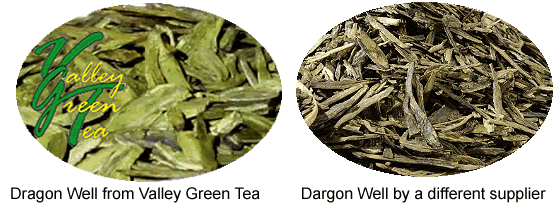What is good quality green tea?
- Print ,
Many people are aware of the health benefits of green teas today due to the frequent publication of research results in the media.
For many green consumers outside of China, their first experiences are often some teabags from a supermarket or stale loose teas from an Asian grocery store. We have heard a lot about the rather negative experiences: bitter, grassy, awful, no taste or even mouldy. This is quite opposite of what the Chinese have experienced for more than 2000 year, a beverage that is aromatic and refreshing, filled with depth and characters.
Two main reasons for negative experiences:
- Low quality tea. Tea is all about quality. There are numerous factors contributing to the quality of the teas, such as the tea plants, geological location of the plantation, seasonal weather conditions, time of harvesting, and tea making knowledge, experience and skills. There is also storage after the tea's production. Over the long history of Chinese tea production, the knowledge and skills of tea making have been highly developed and fine-tuned so that tea making (similar to wine making in the west) has became an art of its own. Contrary to other industrial products, most of the top quality fine teas are snatched up by tea lovers in China and rarely exported.
- Inadequate brewing method. Tea brewing is crucial when it comes to making a good cup of tea. It is important to brew the tea with the right water temperature and adequate timing. For example, use 85-90oC hot water to brew green teas made of young tender leaves (premium green teas) and serve freshly-made, without over steeping. (More preparation Information)
Teabags are rarely consumed in China. Tea's quality deteriorates rapidly as a result of its oxidisation to product the rough texture and bitter taste. This oxidisation process happens many times more in broken leaves than whole leaves. This is the very reason that they are sorted after their production in the sequency (and qualdity order): whole leaf tea, broken leaves, fanning and dust. Only fanning and dust are made into teabag; broken leaves are more often used in blends; whole leaf loose teas head to premium tea market.
Storage is also crucial for green teas. The premium teas are vacuum sealed and refrigerated to avoid elements which are potentially harmful to green teas: high temperature, moisture, light and foreign odours.
There are more than 300 green tea varieties recorded in China. Green tea's production and consumption are highly traditional. Certain well know green teas such Dragon Well and Bi Luo Chun are consumed widely, while many others are produced and consumed in local areas only. The locals normally have the most knowledge about their teas.
There is always a price/quality range within a tea type. For example, for the Dragon Well green tea (leaf tea, not including fanning or dust), the market price could vary a thousandfold between the lowest and top quality. The prices supposedly reflect the quality of the teas, although the correlation it is not always linear.
Indicators of high quality teas:
- Whole leaf tea ( teabags are at the bottom of quality range)
- New season teas are always of better quality
- Adequate packaging and storage. For example, there are certain green teas sold in certain grocery stores which have been exposed to tea damaging factors for a long time: room temperature (premium green teas require below room temperature for long term storage), moisture, air/oxygen contact, light and foreign odours.
 Appearence. Fresh green tea should appear freshly green/deep green/yellowy-green, bright but not dull/dark. Many have a visible white down being the nature of the young tip leaves. This white down is often used as an indication of the proportions of the tip leaves contained in the tea during its grading, the more the better.
Appearence. Fresh green tea should appear freshly green/deep green/yellowy-green, bright but not dull/dark. Many have a visible white down being the nature of the young tip leaves. This white down is often used as an indication of the proportions of the tip leaves contained in the tea during its grading, the more the better.- Right shape. Green teas are in various shapes: flat for Dragon Well, snail shape for Bi Luo Chun and needle shape for Mao Jian. The tea shapes should appear firm and tight. Inconsistent leaf shapes in one tea is an indication of a poor manufacturing process.
- Finally, it is the taste that is the final judge. Fresh high quality green teas should produce an instant aroma once that hot water is added, its tastes should be refreshing with a trace of various nutty flavours and the aftertaste is lingering and delightful.
Tea experience is a personal journey
The more experience you have of one tea, the more you will be able to differentiate the quality and develop your personal preferences regarding how to brew your cup of tea: the tea volume, the brewing time, what vessel to use and even what time of the day to dirnk.


